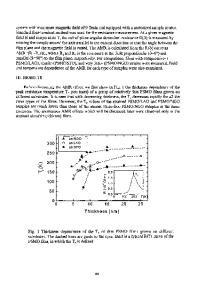Transport Anisotropy in PLD-Made La 0.75 Sr 0.25 MnO 3 Films
- PDF / 708,631 Bytes
- 6 Pages / 391.5 x 607.5 pts Page_size
- 36 Downloads / 271 Views
Seebeck coefficients in orthorhombic
Pr 0.67 Sr 0.33MnO3
and rhombohedral
La 0.67Sr 0o 33MnO 3 single
crystals and found that Seebeck coefficient in the orthorhombic crystal is different in the abplane and along the c-axis at temperatures above the ferromagnetic phase transition temperature, T,. Rhombohedral Lao. 67 Sr0.33 MnO 3 did not show this property and the authors explained this in terms of the difference of Mn-O-Mn bond length and angles. They are different in-ab-plane and out-of-plane for Pr0 .67Sr 0 .33MnO 3 but are the same in Lao, 67Sro.33MnO 3 . Zeng and Wong grew LaO. 67Ca0 .33MnO 3 (001) films on NdGaO 3 substrates by facing target sputtering technique and found resistance anisotropy in-film-plane [6]. Atomic force microscopy images indicated film grown in the step flow mode, with step edges parallel to the c-axis.
83 Mat. Res. Soc. Symp. Proc. Vol. 623 © 2000 Materials Research Society
To investigate the in-plane anisotropy we deposited Lao. 75Sro.2 5MnO 3 (LSMO) films on (110) SrTiO 3 (STO) substrates, with various thickness of 50, 100, 200, 1200 and 2400 A. Strong inplane anisotropy of resistivity has been revealed, with a distinct difference in behavior between the ultrathin (50-200 A) films and the thicker (1200, 2400 A) films. The anisotropy found in LSMO/STO(l 10) thin film structures is also very unlike the above referred effects which are either relatively small and/or disappear below T, Since the transport properties of a uniform cubic crystal should be isotropic, we believe that our results can be explained by the granular structure of LSMO/STO(1 10) films. EXPERIMENT A 248 nm KrF excimer laser was used to ablate a stochiometric target of composition Films were grown on (110) STO 5x5 mm 2 single crystal substrates under the following conditions: substrate temperature was 730 'C, laser radiation energy density was 3-4 J/cm 2 , pulse repetition rate was 30 Hz and the distance between the target and the substrate was 7 55 mm. The background pressure did not exceed 10- Torr. Depositions was carried out in an oxygen pressure of 200 mTorr and finalized by in situ annealing in oxygen pressure of 500 Torr at the same temperature for 10 minutes. The deposition rate has been determined by measuring film thickness with atomic force microscope (AFM). Electrical measurements were performed by standard four-probe dc technique. The four silver contact pads (0 = 0.8 mm) were deposited by thermal evaporation. Magnetoresistance was measured in a field of 7 kOe. The different in-plane directions of the substrate ([1 TO] and [001]) were determined by x-ray diffraction (XRD). A Siemens D5000 powder diffractometer was used for all XRD measurements. AFM measurements were performed with a Burleigh Aris 3300 Personal SPM system using a high aspect ratio (10:1) silicon tip. Lao, 75 Sr 0.2 5 MnO 3 .
RESULTS Transport Characteristics In Fig. 1 the resistivity in the [001] and the [110] directions are showed. The size of the unit cell in the [1 T0] direction is F2 times longer than in the [001] direction. The
Data Loading...










